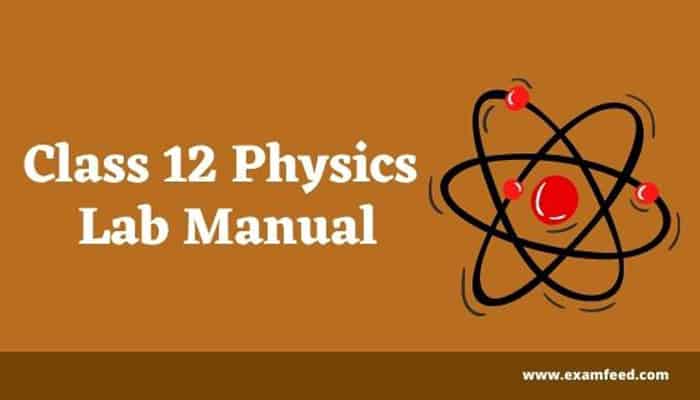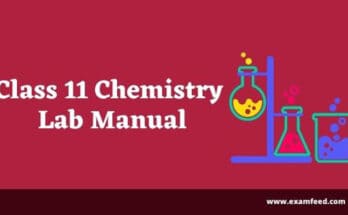The CBSE Physics Class 12 Lab Manual is a very reliable source provided by CBSE to the class XII Students. The Physics Practical for Class 12 Lab Manual consists of various experiments. It is provided in a very well-structured manner so that students can understand the concepts and perform the class 12 physics experiments along with the laws, theorems, principles, and numerical.

In this article, we have listed physics practicals for class 12 CBSE students. With the help of this Class 12th physics practical, you can better prepare for the physics practical examination.
Table of Contents
Physics Practical for Class 12 Lab Manual
Below we have mentioned CBSE Class 12 physics practical experiments list. Students need to check the complete physics practicals class 12 to get good marks in the final practical exam.
| Experiment No. | Aim |
| Experiment 1 | By Plotting a graph of the potential difference (V) against the current (I), Calculate the resistance (R) per centimeter (cm) of the wire. |
| Experiment 2 | Using a Meter Bridge, To calculate the resistance of the given wire and hence find out the resistivity (ρ) of the material. |
| Experiment 3 | To study and verify the laws of combination (series and parallel) of resistance by using the meter bridge. |
| Experiment 4 | Using a Potentiometer, to calculate the internal resistance (r) of a given primary cell. |
| Experiment 5 | To calculate the resistance of a galvanometer by the half deflection method. |
| Experiment 6 | To transform the galvanometer into the ammeter and voltmeter of the desired range. |
| Experiment 7 | To calculate the frequency of alternating current (AC) by using the sonometer and an electromagnet. |
| Experiment 8 | To find the focal length (f) of a convex lens by plotting a graph of u against v or 1/u against 1/v. |
| Experiment 9 | To find out the focal length (f) and for different values of u calculate the values of v (in the case of a concave mirror). |
| Experiment 10 | To find the focal length of a convex mirror and concave lens by using a convex lens. |
| Experiment 11 | To calculate the refractive index (n) of a liquid by using the concave mirror and convex lens. |
| Experiment 12 | To calculate the refractive index (n) of the glass slab by using the traveling microscope. |
| Experiment 13 | To find the reverse breakdown voltage draw the characteristic curve of a Zener diode. |
| Experiment 14 | To draw the current (I) against the Voltage (V) characteristic curve of a PN junction in the forward bias & reverse bias. |
| Experiment 15 | To study the characteristics of a common emitter PNP or NPN transistor and determine the current (I) and voltage (V) gain values. |
Also Read:- Best Physics Investigatory Project for Class 12 CBSE Students
Physics Practical Class 12 Activities
Below we have listed CBSE Class 12 physics Activities list. Students need to check all the physics activities to prepare for the final practical examination.
| Activity No. | Aim |
| Activity 1 | To calculate the impedance and resistance of an inductor with or without an iron core. |
| Activity 2 | To calculate the resistance, voltage (AC/DC), alternating current (AC), and check continuity of a given circuit by using the multimeter. |
| Activity 3 | To construct a household circuit including the three bulbs, three (on/off) switches, a fuse, and a power source. |
| Activity 4 | Gathering the items of the given electrical circuit. |
| Activity 5 | To study the change in the potential drop along with the length of the wire for a steady current. |
| Activity 6 | To draw an open circuit that includes at least the battery, key, resistor/rheostat, voltmeter, and ammeter. Mark the not connected components in the correct order and correct the circuit and circuit diagram. |
| Activity 7 | To identify an LED, a diode, a capacitor, and a resistor from a mixed collection of the items. |
| Activity 8 | In the case of diodes and LEDs, use a multi-meter to see the unidirectional current flow and to examine whether the given electronic component is in working order. |
| Activity 9 | Study of the intensity of light effects on an LDR. (By changing the source distance) |
| Activity 10 | To Study and observe the lateral deviation and refraction of a beam of light incident obliquely on the glass slab. |
| Activity 11 | To Study and observe the polarization of the light by using the two Polaroids. |
| Activity 12 | To Study and observe the diffraction of light due to a thin slit. |
| Activity 13 | To study the size and type of an image formed by a
|
| Activity 14 | By using the two lenses from the given lenses, obtain the combination of the lens along with the defined focal length. |
Final Words
We hope that this Physics Practical for Class 12 helps you a lot. With the help of this physics practical file class 12, you can better prepare for your practical examination.
If you have any questions regarding Class 12 Physics Practical Preparation, feel free to reach out to us through the comment section below and we will definitely help you.
Also, if you looking for seminar topics, project topics, study material, question papers, and syllabus, etc. stay tuned with the Exam Feed.
Frequently Asked Questions (FAQ)
Q.1 How to prepare for the physics class 12 practical examination?
Ans:- Physics Class 12 Lab Manual is a valid resource provided to students by the CBSE board. For the preparation for the practical examination, you have to go through the Physics class 12 lab manual.
Understand and perform all the physics practicals of class 12. So in this way, you can prepare for the final physics practical examination.
Q.2 How to prepare for the physics class 12 board examination?
Ans:- NCERT Books are important books for the preparation of the Physics Board Examination. Read and understand all the concepts, laws, theorems, principles, and formulas.
Regularly practice solving the numerical. Solve the previous year’s questions papers so you’ll get an idea about how questions and numerical will be asked in the board examination.
Q.3 Are diagrams necessary for a practical exam of physics?
Ans:- Yes, diagrams are necessary for the practical examination of physics. Wherever possible try to draw diagrams. Because it gives a precise clear information.



